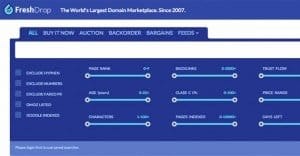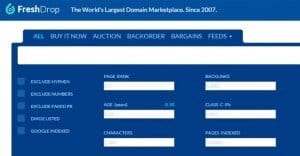How to Find Domains That Get Website Traffic

Your domain name is important. It can hurt or help your business, just by being the passive name everyone comes to use to reference you. How often do you hear about sites like eBay, Amazon, Yahoo or Craigslist? Those are all memorable, branded domain names. On the other hand, how often do your hear about sites like bestsurvivalbackpacks.com or invisiblepinkelephants.com?
The difference here is one of mechanics, between branded domains and exact match domains. In the past, exact match domains have been incredibly powerful, for the same reasons that keywords are powerful. Where’s the best place to put a keyword? In the domain!
Of course, keywords have declined in power with the rise of semantic search. At the same time, Google has been slowly punishing exact match domains, particularly those of low quality.
The Argument for Exact Match Domains
There is a valid argument for the existence of an unpenalized exact match domain. The idea is this; an exact match domain is essentially a billboard advertising that the website in question is dedicated to one subject and one subject only. You don’t go to bestsurvivalbackpacks.com looking for coffee mugs, t-shirts or video games. You go there looking for survival backpacks.
The reasoning is that, when a user is looking for a specific item, a site dedicated to that item would be valuable to have. A user who wants to find survival backpacks would love a page dedicated to those backpacks and nothing else.
The problem, as Google saw it and as webmasters created, was that the ideal was never the reality. The owner of bestsurvivalbackpacks.com – if you go check it right now, it’s a real site – is not in it to be the leading resource of survival backpack information. There’s no list of great products. There’s no comparison amongst brands. There’s nothing but a small blog. Heck, the blog has only been updated once in the last year. The site has affiliate disclosures for links that don’t actually exist, but that’s clearly the intent for the site.
This was the problem with EMDs across the Internet. Rather than becoming valuable resources, they became thin affiliate hogs. Google doesn’t like thin sites with nothing but affiliate links and a few blog posts, and it recognized that the issue was webmasters capitalizing on the keyword domain trend.
Expansion
The problem with EMDs is that they limit your potential for expansion in the future. If the owner of bestsurvivalbackpacks wanted to expand into survival knifes or civilian backpacks, their domain is no longer suitable for the entirety of their business. There are three solutions to this problem.
- Expand anyway and ignore the unsuitable keyword domain.
- Expand and buy up other related URLs, redirecting them to your main site.
- Create more affiliate blogs with EMDs and limited content.
Most affiliate marketers go for number three. The best solution, however, is #4: to make a brand rather than a keyword the central focus of your business. If you’re selling the best survival backpacks and you want to expand into other survival equipment, why not choose a domain you can brand, like survivalguru.com? (That domain is currently parked; you’re welcome.)
Finding the Money Domains
So what does a domain name need in order to make you money? It’s surprisingly hard to find a domain that can accelerate your growth, rather than hurt it over time.
- Avoid keyword-focused domains. They just don’t have the ability to brand later.
- Avoid domain names with too many characters. Pretty much everything catchy is going to be under 12 characters in length. The longer a domain name, the easier it is to typo, and the less memorable it is.
- Look for something catchy. It has to tie in to your business and your brand name. Ideally, it should be as unique as possible as well; you’re not going to get away with www.goooogle.com as a brand.
- Use a .com extension. If the brand name you want is taken in .com, you’re either negotiating to buy it or you’re out of luck. You could have a thriving business named biz net, on biz.net, and people will still type in biznet.com to try to find it.
Is the domain name you want currently taken? Don’t give up just yet. Sometimes, domains are registered or parked by people who aren’t really using them. These people may be willing to sell the domain to you. They also might be about to let the domain lapse, and will allow you to pick it up once it expires.
Buying Expired Money Domains
The Internet is getting older. It has a long history of websites that have died and no longer exist. Some of these websites even had built up followings and may have been making money before they died. One valid technique to make money online is to buy expired domains and run your own website.
In order to do this, you need to make sure the domain you buy isn’t long dead. The longer a domain is dead, the less of its audience is retained. You want to strike while the iron is hot, so to speak, and pick up domains before the majority of the audience even realizes it died.
Since you need to act quickly, you need to have a suite of resources available to estimate or measure the traffic of a domain as it expires or even before. There are three ways you can do this.
The first method is using direct trackers. Sometimes, you can ask the people who own the site about their traffic numbers. This isn’t always the best idea, as the owner may exaggerate or outright lie, in order to get a better price. Unfortunately, there are no direct methods to find traffic on a domain you don’t own. The exception is parked domains, where the domain parker posts statistics in order to make the site more enticing to buy.
The second method is indirect, through traffic analyzers and predictors. You can make estimates based on competitive analysis tools, like SEMRush or SpyFu. You can also check on things like backlink profiles to estimate how often and how recently the site has been linked.
The third method is by reverse-engineering their SEO. What rank do they hold for what keywords? What search volume do those keywords maintain? These can give you an idea of how much traffic a site gets.
Of course, whether or not you make money once you have the domain is an entirely different matter!
 ContentPowered.com
ContentPowered.com




